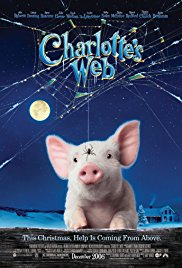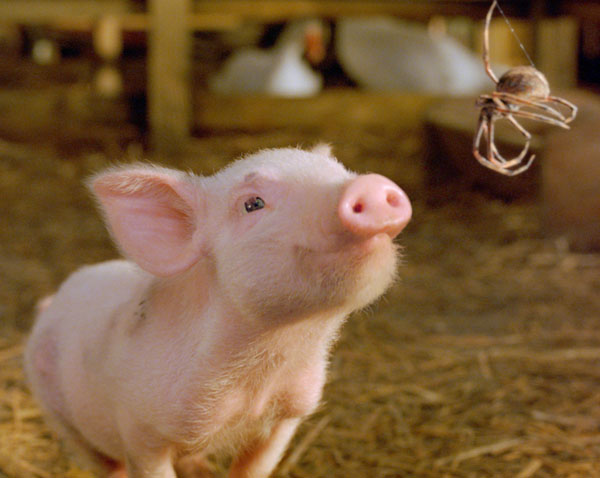E.B. White, the man who wrote Charlotte’s Web, raised a spring pig each year and slaughtered it around Christmas time. One year, the pig that Mr. White was raising got sick, and he had to take care of it. He observed that the pig had a real personality and that it suffered when it was sick. The pig and Mr. White became good friends but the pig never recovered. Eventually, it died from the illness. Mr. White never again looked at pigs as just something to keep confined, to feed, and then to kill for food. As a result of his friendship with the pig who got sick, Mr. White wrote the book Charlotte’s Web.
A FEW FACTS ABOUT PIGS
Pigs are friendly and very smart. In fact, they are the smartest of all the farm animals. Pigs are more intelligent than dogs and cats. Some scientists believe that pigs are as smart as a three-year-old human child. Pigs can figure out how to open and shut gates or push on a lever to get food or a drink of water. They have been taught many skills such as tumbling, to race against one another, to dance, to hunt and to pull carts. Pigs have good memories and can even play simple video games by manipulating the joystick with their snouts.
Pigs are naturally clean animals. When they can get a shower of clean water, pigs prefer it to a roll in the mud. Pigs are not naturally dirty, and they do not defecate in their living areas unless they are confined and have nowhere else to go. When pigs live in fields and in their natural habitat, they use their free time to lie in the sun, play and explore. Their sense of smell is as strong as that of dogs.
You may have heard that pigs eat a lot and will overeat whenever they can. This is pretty much a myth. Many pigs only eat until they have had enough food. Then they stop eating. (Many people can’t control their appetites and will eat too much if a lot of food is placed in front of them.) To get pigs to eat more, farmers feed them a chemical that makes them eat much more than they would normally.
Pigs have social relationships with other pigs. They have families and friends. People have recognized up to 20 different sounds that pigs make which mean different things. Pigs suffer when they are crowded together in small pens, when they are crated up to be moved to the slaughterhouse, and when they are killed. 97% of the pigs raised in the United States are raised in factory farms.
For more interesting pig facts go to Pigs, Pork, Swine Facts from Oklahoma Ag in the Classroom.
A FEW FACTS ABOUT SPIDERS
Charlotte’s description of the life of a spider is pretty accurate, except that they don’t talk or spell. Most spiders live only one season and reproduce by spinning egg sacs. Spiders with webs catch their prey in the web, inject a venom that starts the digestion process and then drinks the digested juice within the animal’s body. (Spiders don’t really drink blood. The prey’s body is predigested by the poison the spider injects making the inside of the prey a kind of soup. The spiders drink the soup.) Young spiders disperse by sending out strands of silk, called balloons, and riding the air currents to a new home.
Spiders have four pairs of legs, eight in all. Their bodies have two major parts, a head region, and an abdomen. These are joined by a narrow waist. At the end of their abdomen, spiders have small fingerlike spinnerets which produce silk. Spiders have a pair of jaw-like structures as part of their head which ends in hollow fangs for injecting venom into their prey. For almost all spiders, these fangs are not strong enough to pierce human skin, however, their jaws can still bite people and spider bites can result in bad infections. Young spiders (spiderlings) look just like the adults, only they are smaller and they may have a different color.
Spiders have an important place in most ecosystems. If spiders didn’t exist, insects like mosquitoes and flies would soon get out of control. People would have to use many more chemicals to control insects.



